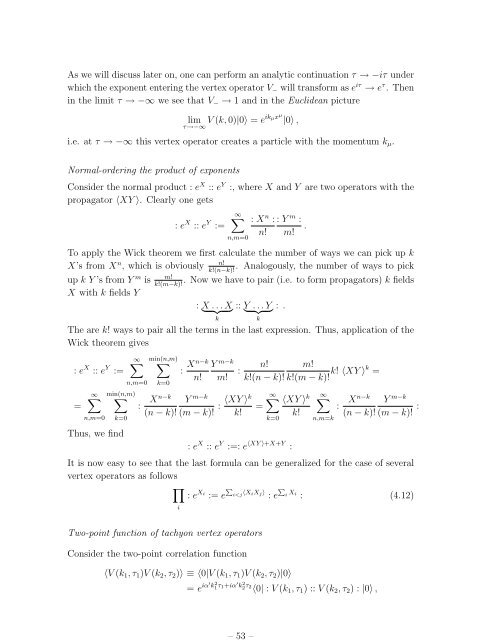Lectures on String Theory
Lectures on String Theory
Lectures on String Theory
You also want an ePaper? Increase the reach of your titles
YUMPU automatically turns print PDFs into web optimized ePapers that Google loves.
– 53 –<br />
As we will discuss later <strong>on</strong>, <strong>on</strong>e can perform an analytic c<strong>on</strong>tinuati<strong>on</strong> τ → −iτ under<br />
which the exp<strong>on</strong>ent entering the vertex operator V − will transform as e iτ → e τ . Then<br />
in the limit τ → −∞ we see that V − → 1 and in the Euclidean picture<br />
lim V (k, 0)|0〉 =<br />
τ→−∞ eik µx µ |0〉 ,<br />
i.e. at τ → −∞ this vertex operator creates a particle with the momentum k µ .<br />
Normal-ordering the product of exp<strong>on</strong>ents<br />
C<strong>on</strong>sider the normal product : e X :: e Y :, where X and Y are two operators with the<br />
propagator 〈XY 〉. Clearly <strong>on</strong>e gets<br />
: e X :: e Y :=<br />
∞∑<br />
n,m=0<br />
: X n : : Y m :<br />
.<br />
n! m!<br />
To apply the Wick theorem we first calculate the number of ways we can pick up k<br />
X’s from X n n!<br />
, which is obviously . Analogously, the number of ways to pick<br />
k!(n−k)!<br />
up k Y ’s from Y m m!<br />
is . Now we have to pair (i.e. to form propagators) k fields<br />
k!(m−k)!<br />
X with k fields Y<br />
: X } .{{ . . X}<br />
:: Y } .{{ . . Y}<br />
: .<br />
k<br />
k<br />
The are k! ways to pair all the terms in the last expressi<strong>on</strong>. Thus, applicati<strong>on</strong> of the<br />
Wick theorem gives<br />
: e X :: e Y :=<br />
=<br />
∞∑<br />
n,m=0<br />
min(n,m)<br />
∑<br />
k=0<br />
Thus, we find<br />
∞∑<br />
n,m=0<br />
:<br />
min(n,m)<br />
∑<br />
k=0<br />
X n−k<br />
: Xn−k<br />
n!<br />
Y m−k<br />
(n − k)! (m − k)!<br />
Y m−k<br />
m!<br />
:<br />
:<br />
〈XY 〉k<br />
k!<br />
n! m!<br />
k!(n − k)! k!(m − k)! k! 〈XY 〉k =<br />
=<br />
∞∑ 〈XY 〉 k<br />
k=0<br />
: e X :: e Y :=: e 〈XY 〉+X+Y :<br />
k!<br />
∞∑<br />
n,m=k<br />
:<br />
X n−k<br />
Y m−k<br />
(n − k)! (m − k)! :<br />
It is now easy to see that the last formula can be generalized for the case of several<br />
vertex operators as follows<br />
∏<br />
: e X i<br />
:= e P i

















